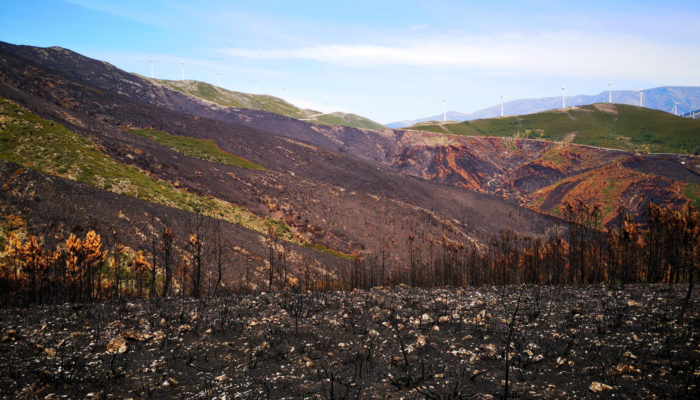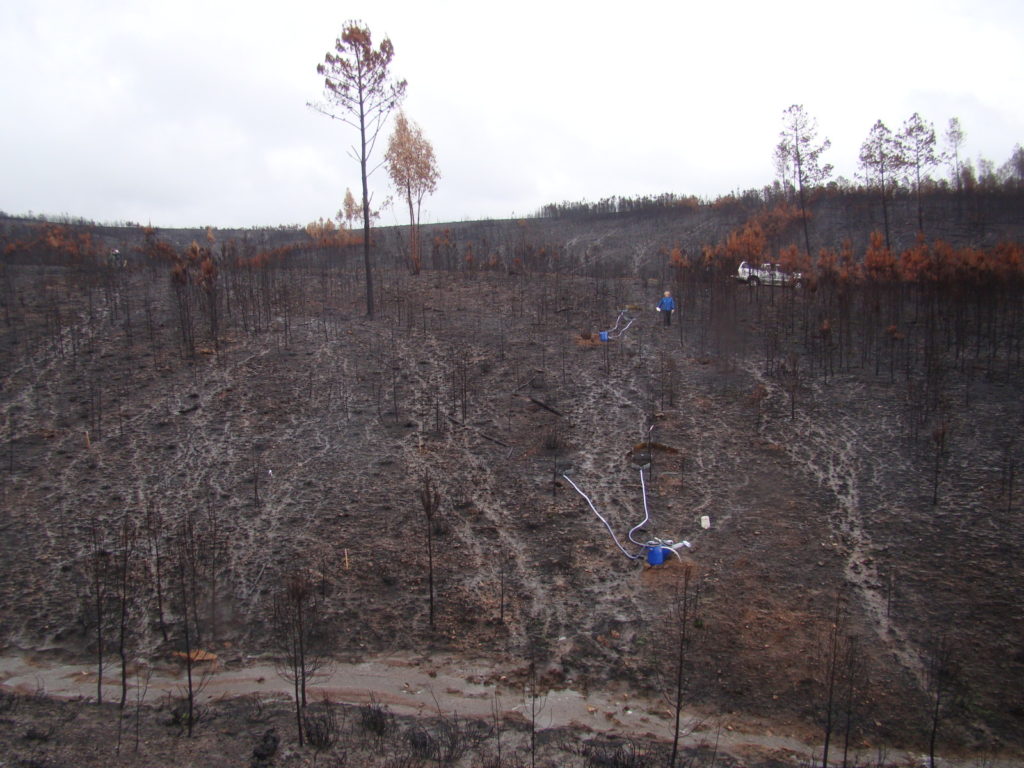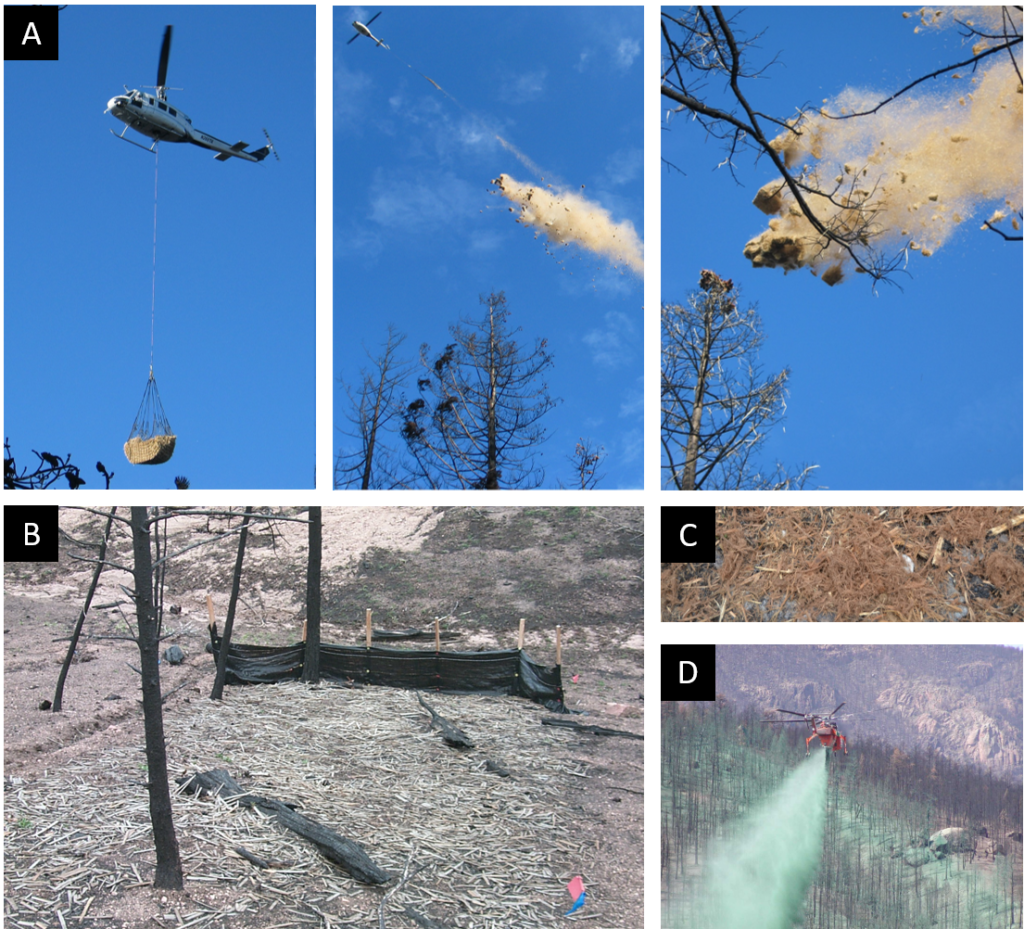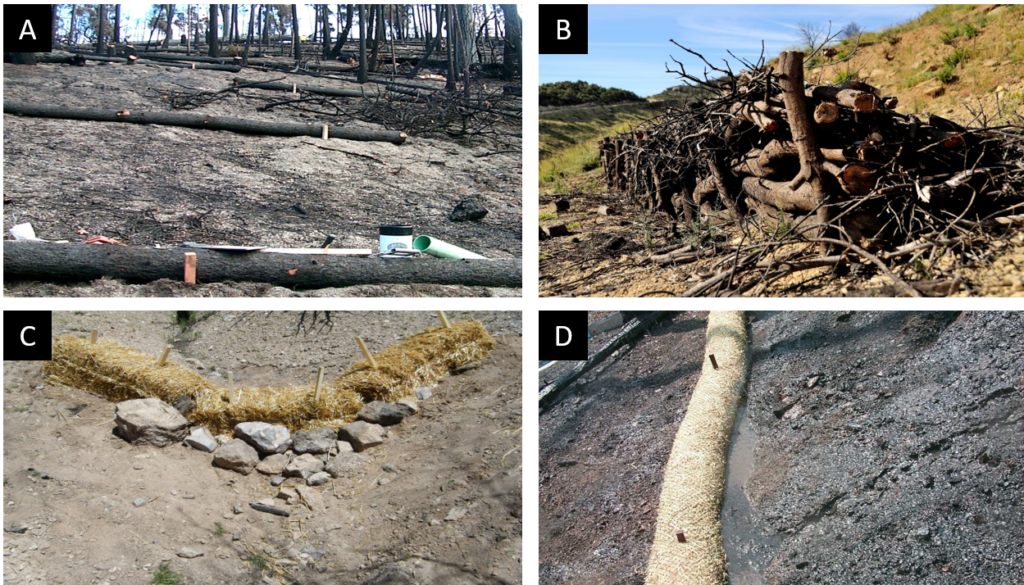
Wildfires are a natural element in many ecosystems and play a central role in their dynamics. For example, they clear forest floors and liberate nutrients that can replenish the soil. However, changes in fire regimes induced by anthropogenic factors (such as climate change and land uses) have resulted in fire patterns that harm ecosystems [1]. Let’s see together the issues and the mitigation solutions according to recent scientific research.
Why is there a need for mitigating erosion after wildfires?
The extent of wildfire-induced changes on ecosystems is based on burn severity, defined as the level of consumption of aboveground and belowground organic matter by the fire [2]. The most apparent modification by wildfires is the elimination of vegetation and litter, leading to the formation of an ash layer and a reduction of rainfall interception. The elimination of the vegetal protective cover alters the soil structure and favours particle detachment during rainfall. Wildfires of moderate to high severity can also destroy soil organic matter and mineral bindings. This aggregate breakdown reduces the volume of pores in the soil, limiting water infiltration, a process that can also be constrained by the development of fire-induced soil water repellency. Altogether, these changes favour runoff production (Figure 1) and particle detachment [3]. This increased post-fire hydrological and erosive response not only has on-site effects but can also have off-site consequences such as destructive floods and debris flows downstream from the burned area.

Figure 1. Soil runoff during an intense rainfall event 1.5 months after the 2012 Várzea wildfire (Portugal). Photo credit: Óscar González-Pelayo, with permission.
How can post-fire soil erosion be mitigated?
Post-fire soil erosion mitigation treatments are usually applied shortly after fires in those areas with a higher risk of soil erosion, namely those burned at high severity. These treatments target the direct and indirect reduction of the effects of raindrops and runoff, thereby favouring water infiltration and limiting the detachment and transport of soil particles (Figure 2).

Figure 2. Representation of the main changes in hydrological and erosive processes after wildfire events and the application of post-fire soil erosion mitigation treatments. Adapted from [4].
The application of protective covers such as straw or wood-residue mulches is one of the most widely used techniques for mitigating erosion in hillslopes because of their cost-effectiveness (Figure 3). Straw mulches are usually obtained from wheat, barley or rye agricultural residues. In contrast, wood-residue mulches comprise a more heterogeneous set of materials in origin (in-situ or ex-situ shredding or chopping of tree barks, branches or logs) and shape (shreds, shavings, strands, or chips). Another type of cover treatment is the hydromulch, a mixture of water, fibre mulches, suspension agents and tackifiers that sometimes are complemented by seeds and chemical improvers.

Figure 3. Photographs of common ground cover treatments for post-fire soil erosion mitigation: A) straw helimulch (2005 School Fire, Washington, USA); B) wood strand mulch (2002 Hayman Fire, Colorado, USA); C) bark strand mulch (2010, Fial das Corzas, Pontevedra, Spain); D) aerial hydromulch application (2002 Hayman Fire, Colorado, USA). Photo credit: Peter R. Robichaud (A, B, D), Cristina Fernández (C).
Barriers are also a common post-fire mitigation treatment that targets the reduction of runoff velocity and increase of water infiltration by shortening the length of uninterrupted flow paths (Figure 4). Commonly in burned areas, barriers consist of felled logs or log debris dams and even straw wattles or bales along the slopes following the contour line. This group of treatments is not only restricted to hillslopes, as it has also been applied in water channels to reduce runoff speed.

Figure 4. Photographs of common barrier treatments for post-fire soil erosion mitigation: A) felled log barriers (2002 Canyon Fire, California, USA); B) log debris dam (2015 Cinco Villas Fire, Orés, Spain); C) straw bale check dams in a temporary channel (2010 Twitchell Canyon Fire, Utah, USA); D) straw wattle barrier (2000 Bitterroot Complex Fire, Montana, USA). Photo credit: Peter R. Robichaud (A, C, D), Antonio Girona-García (B).
Post-fire soil erosion is reduced with vegetation recovery, so some treatments such as seeding favour this process. This treatment typically consists of applying seeds from species native to the area or well adapted to that specific environment. Sometimes, seeding is complemented by the use of fertilisers to increase nutrient availability or surfactant coatings to favour water retention. Seeding has also been frequently combined with straw mulch application in burned areas.
The last treatment that, up to now, has received little attention in post-fire research involves the use of agrichemicals such as polyacrylamides (PAM). They have shown promising results at reducing erosion in agricultural lands at low rates of application. PAMs are flocculants that bind soil particles, improving soil structure and favouring water infiltration. This material also increases the viscosity of overland flow, decreasing its velocity and capacity to detach and transport soil particles, favouring its re-infiltration.
What do we know about post-fire mitigation treatments and the factors involved in their effectiveness?
It is common agreement that the most efficient treatments are those providing a protective cover, playing the role of that destroyed by the fire. In addition, the efficiency of these treatments peaks when they assure a bare soil surface below 30%. However, the effectiveness of cover treatment is highly influenced by the capacity of the materials to remain onsite during rain and wind events and their lifespan. In this sense, straw is more easily removed by wind than wood-residue mulches. Still, if mulches are not evenly distributed, they can impede the recovery of vegetation and even form clumps, concentrating water flow around them, thus increasing erosion. On the other hand, hydromulches seem to be a suitable choice for steep exposed slopes because they bind with the soil, although they are expensive and decompose quickly.
Barriers effectively reduce runoff because they limit water flow, but their effectiveness is heavily determined by their design. In the case of felled log barriers, the efficiency will be based among other factors on their disposition along slopes and degree of ground contact. At the same time, for debris dams, the density of piled materials will determine the percentage of sediment they can retain. The effectiveness of barriers is also limited by their total storage capacity, ultimately determining their lifespan. Contrary to mulching, which prevents the displacement of the soil particles in the soil’s surface, barriers are obstacles to the particles being transported, providing those runoff events allow for the sedimentation of such particles.
Seeding has been frequently used after fires for regeneration purposes. Still, unfortunately, such a method does not provide a protective cover immediately, and depending on post-fire climate conditions, seeds can be even washed away with the first rainfall events. Besides that, the proper functioning of this treatment has also been often compromised by local fauna devouring the seeds given the limited food availability in the burned area or have experienced germination problems because of the scarce water availability, which is aggravated by the occurrence of soil water repellency. Nevertheless, it has also been identified as a post-fire mitigation treatment that benefits when combined with other treatments such as mulch and is more effective in locations with mild rainfall regimes.
We recently conducted a quantitative review on the effectiveness of post-fire mitigation treatments. We identified that factors such as burn severity and the ground cover provided or stimulated by the treatment are important variables influencing treatments efficacy [5]. Firstly, areas burnt at high severities require the most significant investment in post-fire mitigation treatments, considering that the surface of these areas is dominated by bare soil, thus very prone to soil erosion. Secondly, the application of a treatment that can reduce these bare soil areas to the minimum will maximise the post-fire mitigation treatment efficiency.
Naturally, because we are talking about soil erosion processes, one should expect that other factors such as rainfall erosion, topography and scale, play a role in the process. Still, unfortunately, it isn’t easy to separate the impact of these covariates in the post-fire mitigation treatment efficiency with the available data.
What is to be done in post-fire soil erosion mitigation research?
It is necessary to test more types and possible combinations of treatments under different conditions to maximize their effectiveness and ensure that the best treatment is applied for the particular site conditions. These data can then be implemented in erosion models, allowing the prediction of the potential erosion risk and the extent to which each post-fire mitigation treatment can reduce it. The development of post-fire scenarios through model assessment with a wide range of possible post-fire mitigation treatment would improve post-fire management decision-making and more responsible and efficient use of resources [6].
References
[1] Pausas, J.G., Keeley, J.E., 2019. Wildfires misunderstood. Front. Ecol. Environ. 17 (8): 430-431 DOI:10.1002/fee.2107
[2] Keeley, J.E., 2009. Fire intensity, fire severity and burn severity: a brief review and suggested usage. Int. J. Wildland Fire 18: 116-126. DOI: 10.1071/WF07049.
[3] Robichaud, P.R., Beyers, J.L., Neary, D.G., 2000. Evaluating the Effectiveness of Postfire Rehabilitation treatments. Gen. Tech. Rep. RMRS-GTR-63. Fort Collins: U.S.Department of Agriculture, Forest Service, Rocky Mountain Research Station. 85 p.
[4] Vieira, D.C.S., Serpa, D., Nunes, J.P.C., Prats, S.A., Neves, R., Keizer, J.J., 2018. Predicting the effectiveness of different mulching techniques in reducing post-fire runoff and erosion at plot scale with the RUSLE, MMF and PESERA models. Environ. Res. 165: 365-378. DOI: 10.1016/j.envres.2018.04.029
[5] Girona-García, A., Vieira, D.C.S., Silva, J., Fernández, C., Robichaud, P.R., Keizer, J.J., 2021. Effectiveness of post-fire soil erosion mitigation treatments: A systematic review and meta-analysis. Earth-Sci. Revs. 217: 103611. DOI: 10.1016/j.earscirev.2021.103611
[6] Lopes, A.R.; Girona-García, A.; Corticeiro, S.; Martins, R.; Keizer, J.; Vieira, D.C.S. 2021. What is wrong with post-fire soil erosion modelling? A meta-analysis on current approaches, research gaps, and future directions. Earth Surf. Process. Landf. 46 (1): 205-219. DOI: 10.1002/esp.5020
Post edited by Valeria Cigala, Giulia Roder, Gabriele Amato.
